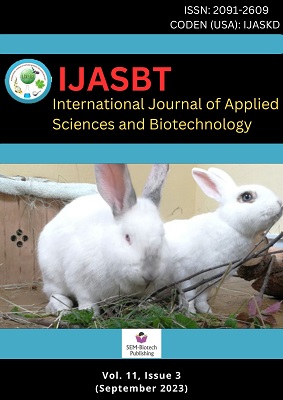Assessment of Soil Nutrient Status Under Different Rice Based Cropping Systems in Ratuwamai Municipality, Morang
DOI:
https://doi.org/10.3126/ijasbt.v11i3.58956Keywords:
Soil Fertility, Soil Nutrient Status, Cropping System, Soil pH, Organic MatterAbstract
The experiment was conducted in Ratuwamai Municipality, Morang, Nepal to assess the impact of various cropping systems on soil fertility and nutrient status. Four different cropping systems (Rice-Wheat-Rice, Rice-Mustard-Maize, Rice-Maize and Rice-Mustard-Rice) were selected as treatments and all treatments were replicated five times in Randomized Complete Block Design. Soil samples from 0-15 cm depth were collected from each site and evaluated for soil pH, Soil Organic Matter content (SOM), Total Nitrogen (N), available phosphorus (P), available potassium (K), sand silt and clay content. All the tested parameters except Soil N content, sand content and clay content were found to be significantly affected by the cropping system. The soil in all four cropping systems were found acidic in nature with pH ranging from (4.18-4.48). The Soil Organic Matter was recorded highest (1.84%) from Rice-Maize based system and lowest amount of Soil Organic Matter was observed in Rice-Mustard-Rice based system. The highest N content (0.19%) was recorded from the Rice-Mustard-Maize cropping system and the lowest N content (0.02%) was recorded from Rice-Wheat-Rice cropping system which is statistically similar to Rice-Mustard-Rice based cropping system. The highest P content (163.95kg/ha) was recorded from Rice-Mustard-Maize and the lowest (75.28kg/ha) was recorded from Rice-Mustard-Rice based cropping system. The highest K content (169.18kg/ha) was recorded from Rice-Mustard-Rice cropping system and the lowest K content (57.76kg/ha) was observed in Rice-Wheat-Rice based system. The highest silt content (48.38%) was recorded from Rice-Mustard-Maize cropping system. The result indicated that the Soil Organic Matter, Nitrogen and Potassium were found to be deficit nutrients in all the cropping system.
Int. J. Appl. Sci. Biotechnol. Vol 11(3): 152-157.
Downloads
Downloads
Published
How to Cite
Issue
Section
License
Copyright (c) 2023 International Journal of Applied Sciences and Biotechnology

This work is licensed under a Creative Commons Attribution-NonCommercial 4.0 International License.




